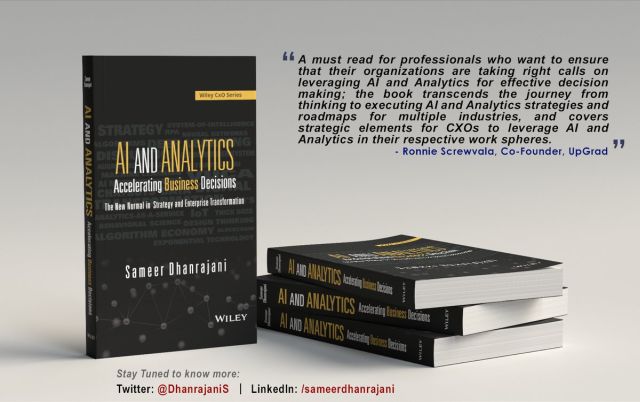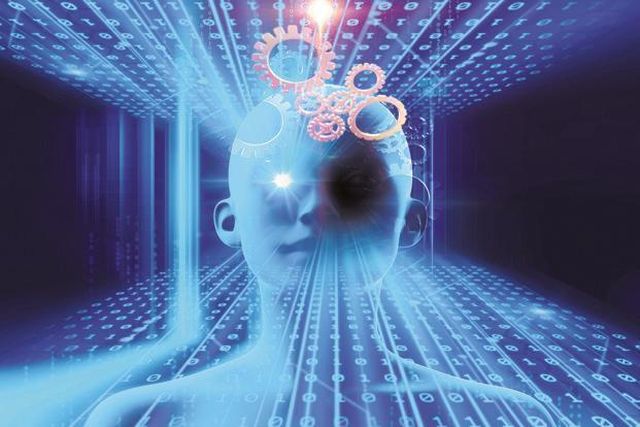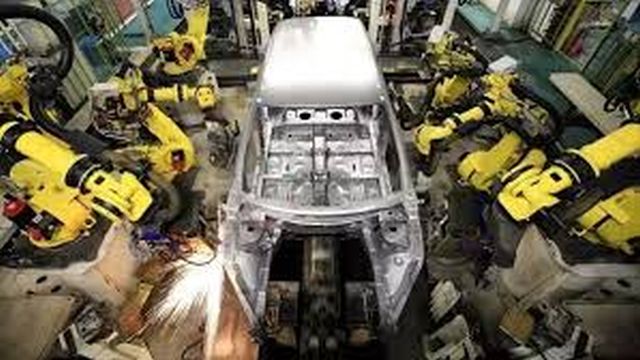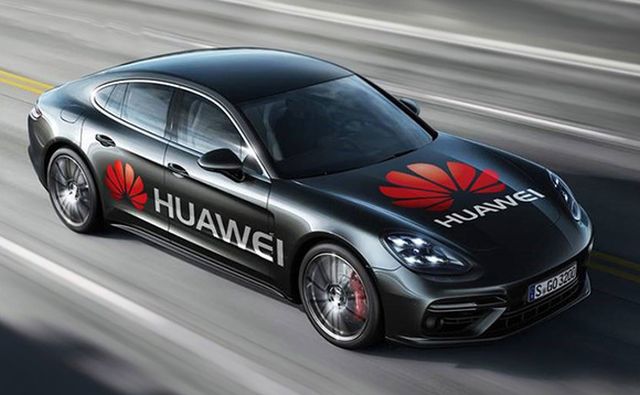
by Editor | May 25, 2021 | Books
 By Gokul Bhagabati,
By Gokul Bhagabati,
Title: AI and Analytics: Accelerating Business Decisions; Author: Sameer Dhanrajani; Publisher: Wiley; Pages: 372; Price: 599
Analytics and Artificial Intelligence (AI) — concepts that seemed to be lofty ideals not so long ago — have suddenly started sounding all too familiar thanks to their widespread use by some of the world’s biggest internet companies. But these technologies won’t remain a fiefdom of a few. Nor should they, argues a powerful new book.
On the face of it, only a few tech giants like Google, Apple, Facebook or Amazon seem to be ready to maximise the adoption of analytics and AI and reap their benefits.
For example, anyone using Gmail would know how Google has used analytics to sort emails in different categories to help its users get to the important messages fast. Amazon’s Alexa, Apple’s Siri or Google’s Assistant that can now perform a wide variety of tasks using AI – from setting up alarms to playing songs — hardly need any introduction.
But Sameer Dhanrajani, in his book “AI and Analytics: Accelerating Business Decisions”, argues that not many companies — especially those that are neither in the e-commerce business, nor strictly tech companies — have been successful in adopting these technologies.
In other words, only a few companies have been able to make use of these technologies to give their organisations a sustainable competitive advantage over their competitors. And this is despite the fact that most companies now realise that adopting analytics and AI is a must to stay afloat in the future.
Dhanrajani, who has a rich experience of building AI and Analytics businesses for a number of organisations, including Cognizant Technology Solutions, knows that these companies need guidance, and most of all encouragement, in utilising the data stored in silos of their organisations through analytics and AI.
Dhanrajani has been helping these businesses approach the problem with practical insights for quite some time now with his blogs and lectures at business conferences, and his latest book is also a step in the same direction.
The book is divided into two parts. The first part details what businesses, including start-ups with budget constraints, need to do to transform their businesses with AI and analytics.
Most importantly, Dhanrajani explains that lack of understanding of the meaning of analytics, a talent crunch, and a view that it is an expensive, esoteric subject may emerge as stumbling blocks in implementation of these technologies.
He offers strategies to enterprises to overcome these hindrances while laying out a roadmap for them in implementing these technologies to make their organisations smarter by increasing operational efficiencies and improving customer relationship management, while reducing risks arising out of internal decisions and external threats.
For, Dhanrajani believes that analytics has the ability to combine data from numerous data sources in interesting ways and offer deep insights into the impact of business decisions.
What makes the book an interesting read is that the author’s recommendations are nicely punctuated with examples of specific initiatives that have helped some of the world’s well-known enterprises leverage these technologies.
The second part of the book provides details about the transformations brought about by AI and analytics for multiple industries – banking and insurance, healthcare and life sciences, retail and consumer packaged goods.
In this part, the author also devotes a separate section to the relevance of AI and analytics in autonomous vehicles, Internet of Things (IoT), chatbots, implementation of blockchain technology, and in beating cyberattacks.
It is not without any reason that Dhanrajani wants to help all organisations embrace the AI and analytics. First, unlike many thinkers, Dhanrajani does not believe that AI would become an existential threat to humanity. According to him, humans and AI will co-exist in the future as humans will be sensitive enough to create contingencies to ensure that autonomous machines do not harm us.
He also believes that the world is on the verge of having a data-driven economy where AI and analytics would be the driving force of success for most organisations.
Reading this book may not guarantee successful implementation of AI and analytics in an organisation, but it may encourage many to take the right steps. And who knows, it may help some to say hello to the future with greater confidence.
The title and small fonts used in the text may give some readers the impression that reading this book would be one tough row to hoe. Far from it, the small chapters and the easy narrative make reading it a pleasant experience, and also quite enlightening.
(Gokul Bhagabati can be contacted at gokul.b@ians.in)
—IANS

by Editor | May 25, 2021 | Business, Corporate, Corporate Buzz, Corporate Governance, Markets, Medium Enterprise, SMEs, Technology
 By Nishant Arora,
By Nishant Arora,
Seattle (Washington) : While the Artificial Intelligence (AI) technology is making its presence felt across the spectrum globally, India needs to prioritise AI-based predictive analysis to improve outcomes in three core areas — agriculture, healthcare and education, a top Microsoft executive has emphasised.
The initial results in India are promising and if deployed at big scale, AI-based models can help farmers, doctors and educators keep building success stories, Joseph Sirosh, Corporate Vice President of Cloud AI Platform at Microsoft, told IANS here.
“For example, AI can help us foresee signs of a student being at risk of dropping out. We have done first such experiment in Andhra Pradesh involving thousands of students,” Sirosh informed.
In 2017, the Andhra Pradesh government expanded the rollout of the experiment to all 13 districts in the state.
In Visakhapatnam district, an application powered by Azure Cloud Machine Learning (ML) processed the data pertaining to all students — based on parameters such as gender, socio-economic demographics, academic performance, school infrastructure and teacher skills — to find predictive patterns.
The results showed that some of the factors leading to students dropping out were insufficient furniture, inadequate toilet infrastructure, etc.
Based on these results, the state government identified about 19,500 probable dropouts from government schools in Visakhapatnam district in the next academic year (2018-19).
“Not just India, AI-based predictive analysis has also helped Tacoma School District here in Washington state improve graduation rate from under 60 per cent to over 83 per cent by managing dropouts,” Sirosh noted.
When it comes to agriculture, Microsoft, in collaboration with the non-profit International Crop Research Institute for the Semi-Arid Tropics (ICRISAT), has developed an AI-sowing app for farmers in India.
The tech giant is using AI and historic weather data to predict the best time for sowing seeds and other stages of the farming process, and pass on that information to farmers via SMS.
“We have done some amazing work, like informing farmers when to sow crops, what is the best time to plant crops during the year, etc. The result is 30 per cent more yield,” Sirosh told IANS.
The farmers do not need to install any sensors in their fields or incur any capital expenditure. All they need is a mobile phone capable of receiving text messages.
To determine the optimal sowing period, the Moisture Adequacy Index (MAI) is calculated. MAI is the standardised measure used for assessing the degree of adequacy of rainfall and soil moisture to meet the potential water requirement of crops.
The data then is downscaled to build predictability and guide farmers to pick the ideal sowing week.
According to Microsoft, ICRISAT has scaled sowing insights in 2018 to 4,000 farmers across Andhra Pradesh and Karnataka for the Kharif crop cycle (rainy season).
“We have made AI-based applications very simple for common people to comprehend. They don’t need to be tech-sophisticated. We have simplified the technology for the end-users,” Sirosh added.
The company has also developed a multi-variate agricultural commodity price forecasting model to predict future commodity arrival and the corresponding prices.
The model uses remote sensing data from geostationary satellite images to predict crop yields through every stage of farming.
According to the company, the model, currently being used to predict the prices of “tur” pulse, is scalable and can be generalised to other regions and crops.
On the health front, the Telangana government has adopted Microsoft Intelligent Network for Eyecare (MINE), which was developed in partnership with Hyderabad-based LV Prasad Eye Institute.
MINE uses ML and advanced analytics to predict regression rates for eye operations, enabling doctors to pinpoint the procedures needed to prevent and treat visual impairments.
“Under the MINE global consortium, we have built AI models that are very accurate for eyecare, especially for children,” Sirosh said.
The Telangana government is using Microsoft’s Cloud-based advanced analytics solution to screen children from birth to 18 years of age for major conditions affecting their health.
“We are also working hard to improve citizen services in India by creating user-friendly application programming interfaces (APIs) for enhanced speech recognition and translation solutions,” Sirosh added.
People are just starting to understand the power of AI-enabled Cloud in India.
“Our partners like TCS, Wipro, Infosys, Cognizant and Accenture are leaning in and adopting AI. These are exciting times for AI and its real adoption in the country,” Sirosh said.
(Nishant Arora was in Seattle on an invitation from Microsoft. He can be reached at nishant.a@ians.in)
—IANS

by Editor | May 25, 2021 | Business, Investing, Large Enterprise, Marketing Basics, Markets, Online Marketing, Social Media, Technology
 New Delhi : Twitter co-founder Biz Stone has invested in a Delhi-based Artificial Intelligence (AI)-powered chatbot “Visit” which is the brainchild of students from Birla Institute of Technology and Science (BITS), Pilani in Rajasthan.
New Delhi : Twitter co-founder Biz Stone has invested in a Delhi-based Artificial Intelligence (AI)-powered chatbot “Visit” which is the brainchild of students from Birla Institute of Technology and Science (BITS), Pilani in Rajasthan.
Stared in 2016 by Anurag Prasad, Vaibhav Singh, Shashvat Tripathi and Chetan Anand, “Visit” is an AI-powered chatbot for health advice learning from, and assisting, existing doctors.
“People interact with the ‘Visit’ chatbot by sharing some symptoms. The bot follows up with relevant questions to collect more symptoms and risk factors (is the person hypertensive, diabetic, a smoker). This triaging is conversational and low stress,” Stone wrote in a blog post on Medium on Sunday.
“Visit” plans to democratise healthcare by shrinking the shortage of doctors using AI.
“In India, for every doctor there are 2,000 patients lined up in-clinics — waiting for hours.
“Accessibility to quality health advice is an overwhelming problem in a country with over 200 million people affected by lifestyle problems like stress, chronic conditions, obesity, skin conditions, and more. This is where the technology approach by aVisit’ comes in,” Stone informed.
“Visit” chats conclude with patients being more educated about possible conditions, symptoms, and treatments.
The chatbot is trained using over 20,000 probabilistic relationships between variables such as conditions, symptoms, risk factors, past history and more.
Once a probable medical condition is determined, “Visit” connects the patient to one of over 2,000 health specialists all across India via video, phone or chat so the right treatment can be put into place.
“But it doesn’t end there. People can stay in touch with their practitioner over chat for follow-up. The objective is not to replace the doctor but to help practitioners in an assistive way by regular patient check-ins and reminders related to their care plan,” Stone noted.
“Investing in Visit is my small way of contributing to a future where AI is seen as a positive enhancement of humanity that really does improve lives,” he added.
—IANS

by Editor | May 25, 2021 | Opinions

For representational purpose only
By Arnav Joshi,
While much of the world is busy worrying about losing jobs to automation in the future (and this is overstated), what has crept past for over a decade is that automated systems (to most, Artificial Intelligence, or AI) already play a major role in whether or not — and how — we get the jobs we still have, and these are used by a steadily growing number of Indian and multinational companies.
The current breed of algorithmically-driven, automated decision-making systems warrant our attention and alarm. All but ubiquitous, particularly in mass hiring, these systems are largely opaque as to their decision-making process, potentially making many unethical (or illegal) decisions, whilst dehumanising the hiring process in general.
Usually, the bigger the company, the more the applicants, the wider the automation, and larger the potential of being “wronged” by a machine. Lured in by sales pitches peppered with higher productivity and lower costs and attrition, who wouldn’t want to use them?
There are benefits, but they don’t outweigh the concerns yet. What often goes unseen is how the secrecy around the deployment of these systems (ironically, in part owing to the fear of them being gamed) combined with a lack of both awareness and adequate legal safeguards creates a deadly cocktail of misuse of personal data, automated discrimination, and abject uncertainty for hundreds of millions of job-seekers.
So what does an applicant drowning in rejection emails do? The Guardian, in a rather click baiting-ly titled piece, “How to persuade a robot that you should get the job”, (inadvertently) offers up some solutions, seemingly suggesting that there are ways in which you and I can, in fact, fight back against the machine.
After highlighting the plight of the job-seeker in the age of AI, towards the end, where one expects a silver lining, the article gets into how people discuss and offer various ways to stress-test and “game” the system. One ludicrous solution comes up (citing “an HR employee for a major technology company”) — slipping words such as “Oxford” and “Cambridge” into your CV in invisible text to pass automated screenings. It may not be The Guardian’s, but it’s someone’s solution, arguably offered to almost 25 million readers, without raising the red flag about its potential futility.
Complex machine learning systems that parse and analyse things like CVs to assess candidates are not yet the stuff of Elon Musk’s worst nightmare, but they’re not so gullible either. For starters, many of these systems use tonnes of other data points — social media posts, video essays, scroll speed, text entered (and deleted), and much more is logged and analysed. The systems learn quickly and constantly from this perennial supply of training data, using incredibly complex neural networks we cannot yet adequately comprehend, to draw correlations they themselves cannot justify. Just how many things can a candidate hope to adapt to for a system he knows nothing about?
Michael Veale, a prominent researcher in automated decision systems at the University College London adds that “While there are a lot of studies lately pointing to how individuals can ‘fool’ machine learning systems, they tend to require people to have access to the systems already. That’s a cybersecurity problem more than anything.” And that even where a candidate thinks he or she may succeed, “It is definitely possible to adapt systems if they are being gamed, but it’s not assured it will happen. More likely than not, attempts at gaming will just make systems useless.”
What would it take a system like this to game the gamer? Not much at all. Would an application that would otherwise have been selected by such a system be binned because it attempted to use invisible ink? A raised eyebrow? A certain number of words per minute? We just don’t know. Systems also change from company to company and vary by narrow contexts — there are no catch-all solutions.
What we do know is that someone hoping to achieve a different (positive) outcome thanks to slapdash measures is likely to come out feeling far more dejected when rejected — for if even gaming didn’t work, they must really not be good enough. That is not it, the problem (most often) is not with the applicant. First and foremost, this is the message that needs to go out.
What should you really be doing? There is no quick-fix solution, and not as simple as invisible ink. The silver lining, however, is that the movement towards greater fairness, accountability and transparency is already well under way. Long overdue updates in data protection regulations are also on the anvil, including in India, which will directly challenge many of the automated hiring solutions companies currently offer, severely restricting complete automation as well as what data they can gather, how they gather it and what they can do with it — a big departure from the current free-for-all data (mis)use.
As interim measures, candidates should first work towards making themselves more aware about the level and scale of automation, and asking the right (and difficult) questions of their potential employers. While polite emails may not get clear answers, in more severe instances where you feel you may have been unfairly discriminated against by an automated system, consider taking a slightly more formal, legal approach.
When it comes to hiring, there are already laws that require employers to account for equality, anti-discrimination and disparate impact — and these apply to an algorithm as much as they do to hiring manager John Doe. While systems can (in some cases) be designed to ignore certain attributes in an attempt at fairness and equality, this is not a comprehensive solution (for technical reasons to do with machine learning that I won’t get into here).
When companies know they are unlikely to be able to prove that their automated hiring process was (legally) fair, a letter from your lawyer or professional association will get them breaking into a sweat.
There is also fantastic academic and data activism research taking place in many parts of the world, applying various methodologies, old and new, attempting to reveal the many issues with widely used automation systems, holding their makers and users to account. What researchers often lack is data, being outside actors, locked out of the companies they would like to audit. Use your data for good — contribute it meaningfully to sound, ethical research which needs it to effect change.
For the companies themselves, should growing awareness and potential legal challenges prompt a rethink, Veale suggests that rather than over-reliance on automation and trying to remove the human element altogether, “They should be investing in ways to better help their employees sift through applications in computational ways. Data visualisation tools and user interfaces also enable people to deal with great numbers of applications, and they’re often lacking and lagging behind right now. Use computers to help humans make decisions, not to help humans offload decision-making responsibilities.”
(Arnav Joshi is a technology lawyer, Data and Society masters candidate and data ethics researcher at the London School of Economics and Political Science. He can be reached via twitter @boom_lawyered)
—IANS

by Editor | May 25, 2021 | Markets, Networking, Technology
 Barcelona : In a first, Huawei has unveiled a technology that uses Artificial Intelligence-enabled smartphone to drive a car that can not only identify objects on the road but take smart decisions to avoid collisions or hitting someone.
Barcelona : In a first, Huawei has unveiled a technology that uses Artificial Intelligence-enabled smartphone to drive a car that can not only identify objects on the road but take smart decisions to avoid collisions or hitting someone.
In a video released by the China-based technology giant, the driverless Porsche Panamera is controlled by Huawei’s flagship “Mate 10 Pro” smartphone that can “understand its surroundings”.
“Our smartphone is already outstanding at object recognition. We wanted to see if in a short space of time we could teach it to not only drive a car, but to use its AI capabilities to see certain objects, and be taught to avoid them,” said Andrew Garrihy, Chief Marketing Officer at Huawei Europe.
According to a report in theinquirer.net on Friday, Huawei’s ‘RoadReader’ project “pushed the boundaries of its object recognition technology and put the learning capabilities, speed and performance of its AI-powered devices to the test”.
During the test, the smartphone-driven car did not hit a real dog sitting right in the middle of the road and moved on from the side.
The camera app on the “Mate 10 Pro” can tell the difference between food, pets, landscapes and more.
Huawei will showcase its “RoadReader” project at the Mobile World Congress (MWC) in Barcelona, Spain on February 26-27.
—IANS





